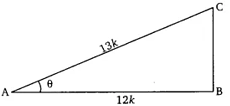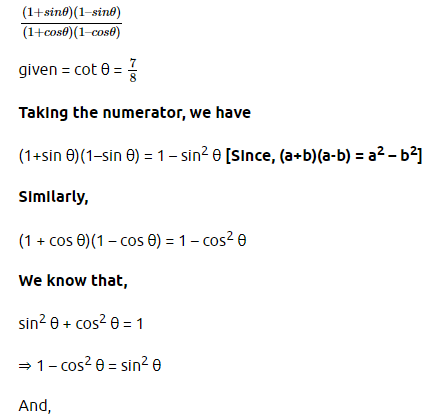Physical Address
304 North Cardinal St.
Dorchester Center, MA 02124
1. In Δ ABC, right-angled at B, AB = 24 cm, BC = 7 cm. Determine :
(i) sin A, cos A
(ii) sin C, cos C
Answer:
Let us draw a right angled triangle ABC, right angled at B.
Using Pythagoras theorem,

(i) 

(ii)
 ,
,
2. In adjoining figure, find tan P – cot R.

Answer:


3. If sin A =3/4, calculate cos A and tan A.
Answer:
Given: A triangle ABC in which

B =90
We know that sin A = BC/AC = 3/4
Let BC be 3k and AC will be 4k where k is a positive real number.
By Pythagoras theorem we get,
AC2 = AB2 + BC2
(4k)2 = AB2 + (3k)2
16k2 – 9k2 = AB2
AB2 = 7k2
AB = √7 k
cos A = AB/AC = √7 k/4k = √7/4
tan A = BC/AB = 3k/√7 k = 3/√7
4. Given 15 cot A = 8, find sin A and sec A.
Answer:

Let ΔABC be a right-angled triangle, right-angled at B.
We know that cot A = AB/BC = 8/15 (Given)
Let AB be 8k and BC will be 15k where k is a positive real number.
By Pythagoras theorem we get,
AC2 = AB2 + BC2
AC2 = (8k)2 + (15k)2
AC2 = 64k2 + 225k2
AC2 = 289k2
AC = 17 k
sin A = BC/AC = 15k/17k = 15/17
sec A = AC/AB = 17k/8 k = 17/8
5. Given sec θ = 13/12, calculate all other trigonometric ratios.
Answer:
Consider a triangle ABC in which

Let AB = 12k and AC = 13k
Then, using Pythagoras theorem,
(AC)2 = (AB)2 + (BC)2
(13 k)2 = (12 k)2 + (BC)2
169 k2 = 144 k2 + BC2
25 k2 = BC2
BC = 5 k
(I) Sin ![]() =
= ![]()
= ![]() =
= ![]()
(ii) Cos θ = ![]()
= ![]() =
= ![]()
(iii)Tan θ = ![]()
= ![]() =
= ![]()
(iv) Cot θ = ![]()
= ![]() =
= ![]()
(v) Cosec θ = ![]()
= ![]() =
= ![]()
6. If ∠A and ∠B are acute angles such that cos A = cos B, then show that ∠A = ∠B.

Answer:
cosA=cos
But 
7. If cot θ =7/8, evaluate :
(i)(1+sin θ )(1-sin θ)/(1+cos θ)(1-cos θ)
(ii) cot2θ
Answer:
Consider a triangle ABC


(ii)

8. If 3cot A = 4/3 , check whether (1-tan2A)/(1+tan2A) = cos2A – sin2A or not.
Answer:
Consider a triangle ABC AB=4cm, BC= 3cm
 .
.

And 


9. In triangle ABC, right-angled at B, if tan A =1/√3 find the value of:
(i) sin A cos C + cos A sin C
(ii) cos A cos C – sin A sin C
Answer:
Consider a triangle ABC in which
 .
.
(i)

(ii)

10. In Δ PQR, right-angled at Q, PR + QR = 25 cm and PQ = 5 cm. Determine the values of sin P, cos P and tan P.
Answer:
Given that, PR + QR = 25 , PQ = 5
Let PR be x. ∴ QR = 25 – x
By Pythagoras theorem ,
PR2 = PQ2 + QR2
x2 = (5)2 + (25 – x)2
x2 = 25 + 625 + x2 – 50x
50x = 650
x = 13
∴ PR = 13 cm
QR = (25 – 13) cm = 12 cm
sin P = QR/PR = 12/13
cos P = PQ/PR = 5/13
tan P = QR/PQ = 12/5
11. State whether the following are true or false. Justify your answer.
(i) The value of tan A is always less than 1.
(ii) sec A = 12/5 for some value of angle A.
(iii) cos A is the abbreviation used for the cosecant of angle A.
(iv) cot A is the product of cot and A.
(v) sin θ = 4/3 for some angle θ.
Answer:
i) False.
In ΔABC in which ∠B = 90º,
AB = 3, BC = 4 and AC = 5
Value of tan A = 4/3 which is greater than.
The triangle can be formed with sides equal to 3, 4 and hypotenuse = 5 as
it will follow the Pythagoras theorem.
AC2 = AB2 + BC2
52 = 32 + 42
25 = 9 + 16
25 = 25
(ii) True.
Let a ΔABC in which ∠B = 90º,AC be 12k and AB be 5k, where k is a positive real number.
By Pythagoras theorem we get,
AC2 = AB2 + BC2
(12k)2 = (5k)2 + BC2
BC2 + 25k2 = 144k2
BC2 = 119k2
Such a triangle is possible as it will follow the Pythagoras theorem.
(iii) False.
Abbreviation used for cosecant of angle A is cosec A.cos A is the abbreviation used for cosine of angle A.
(iv) False.
cot A is not the product of cot and A. It is the cotangent of ∠A.
(v) False.
sin θ = Height/Hypotenuse
We know that in a right angled triangle, Hypotenuse is the longest side.
∴ sin θ will always less than 1 and it can never be 4/3 for any value of θ.
| CHAPTER NAME | OLD NCERT | NEW NCERT | |
| Real Numbers | EXERCISE 1.1 | ||
| EXERCISE 1.2 | 1.1 | CLICK HERE | |
| EXERCISE 1.3 | 1.2 | CLICK HERE | |
| EXERCISE 1.4 | |||
| Polynomials | EXERCISE 2.1 | 2.1 | CLICK HERE |
| EXERCISE 2.2 | 2.2 | CLICK HERE | |
| EXERCISE 2.3 | |||
| EXERCISE 2.4 | |||
| Pair of Linear Equations in Two Variables | EXERCISE 3.1 | ||
| EXERCISE 3.2 | 3.1 | CLICK HERE | |
| EXERCISE 3.3 | 3.2 | CLICK HERE | |
| EXERCISE 3.4 | 3.3 | CLICK HERE | |
| EXERCISE 3.5 | |||
| EXERCISE 3.6 | |||
| EXERCISE 3.7 | |||
| Quadratic Equations | EXERCISE 4.1 | 4.1 | CLICK HERE |
| EXERCISE 4.2 | 4.2 | CLICK HERE | |
| EXERCISE 4.3 | |||
| EXERCISE 4.4 | 4.3 | CLICK HERE | |
| Arithmetic Progressions | EXERCISE 5.1 | 5.1 | CLICK HERE |
| EXERCISE 5.2 | 5.2 | CLICK HERE | |
| EXERCISE 5.3 | 5.3 | CLICK HERE | |
| EXERCISE 5.4 | 5.4 (Optional) | CLICK HERE | |
| Triangles | EXERCISE 6.1 | 6.1 | CLICK HERE |
| EXERCISE 6.2 | 6.2 | CLICK HERE | |
| EXERCISE 6.3 | 6.3 | CLICK HERE | |
| EXERCISE 6.4 | |||
| EXERCISE 6.5 | |||
| EXERCISE 6.6 | |||
| Coordinate Geometry | EXERCISE 7.1 | 7.1 | CLICK HERE |
| EXERCISE 7.2 | 7.2 | CLICK HERE | |
| EXERCISE 7.3 | |||
| EXERCISE 7.4 | |||
| Introduction to Trigonometry | EXERCISE 8.1 | 8.1 | CLICK HERE |
| EXERCISE 8.2 | 8.2 | CLICK HERE | |
| EXERCISE 8.3 | |||
| EXERCISE 8.4 | 8.3 | CLICK HERE | |
| Some Applications of Trigonometry | EXERCISE 9.1 | 9.1 | CLICK HERE |
| Circles | EXERCISE 10.1 | 10.1 | CLICK HERE |
| EXERCISE 10.2 | 10.2 | CLICK HERE | |
| Construction | |||
| Areas Related to Circles | EXERCISE 12.1 | ||
| EXERCISE 12.2 | 11.1 | CLICK HERE | |
| EXERCISE 12.3 | |||
| Surface Areas and Volumes | EXERCISE 13.1 | 12.1 | CLICK HERE |
| EXERCISE 13.2 | 12.2 | CLICK HERE | |
| EXERCISE 13.3 | |||
| EXERCISE 13.4 | |||
| EXERCISE 13.5 | |||
| Statistics | EXERCISE 14.1 | 13.1 | CLICK HERE |
| EXERCISE 14.2 | 13.2 | CLICK HERE | |
| EXERCISE 14.3 | 13.3 | CLICK HERE | |
| EXERCISE 14.4 | |||
| Probability | EXERCISE 15.1 | 14.1 | CLICK HERE |
| EXERCISE 15.2 |